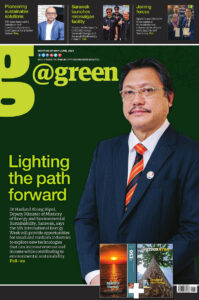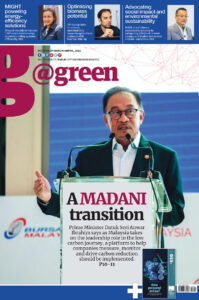Singapore remains well-positioned to contribute expertise towards the modelling of the fund
With a highly networked food supply chain, Singapore gets its food supply, directly or indirectly, from agricultural-based developing economies such as Pakistan, Ivory Coast and Sri Lanka.”
 After two weeks of high-level and side events, key negotiations and Press conferences that witnessed the attendance of more than 100 Heads of State and 35,000 participants spanning numerous pavilions showcasing their work and ambitions across climate change in the Egyptian coastal city of Sharm-el-Shiekh, a historic milestone was struck at the eleventh hour.
After two weeks of high-level and side events, key negotiations and Press conferences that witnessed the attendance of more than 100 Heads of State and 35,000 participants spanning numerous pavilions showcasing their work and ambitions across climate change in the Egyptian coastal city of Sharm-el-Shiekh, a historic milestone was struck at the eleventh hour.After intense negotiations, a decision was made to establish a loss and damage fund.
For the longest time, developing countries have been making their case for financial assistance for loss and damage. The funds are required to rebuild and rescue the physical and social infrastructure of developing countries ravaged by extreme weather, including floods and droughts, over the last couple of decades.
While this is a step in the right direction, it must be noted that no agreement was reached at COP27 on how finance should be provided and where from it should come. Rules around donors, recipients of this fund and fund accessibility have yet to be ironed out.
Much work remains to be done in operationalising and implementing this fund. It should be ensured that it is sufficiently resourced and fit-for-purpose in serving communities and indigenous people most in need of financial assistance, many of whom have suffered irreparable and irreversible losses of their lands and traditions.
More importantly, the fund should be rules-based and grounded on common and differentiated responsibilities. Of particular importance, COP27 marked the first environmental negotiation process to explicitly refer to the human right to a clean and healthy planet.
Playing a key role
Restoring damaged mangrove swamps and regrowing forests that have gone barren can help developing and poorer countries become more resilient to the impacts of climate change.
But emerging countries often struggle to gain funding for these efforts and are left to feed off financial aid offered by institutions such as the World Bank and other publicly funded financial institutions.
Singapore can play a key role in shaping and contributing to the loss and damage fund. Being a net importer of goods, Singapore must play its part in ensuring an equitable planet where human rights and climate justice is not compromised.
With a highly networked food supply chain, Singapore gets its food supply, directly or indirectly, from agricultural-based developing economies such as Pakistan, Ivory Coast and Sri Lanka.
A quick check on these countries would reveal that all have them have been subject to the realms of catastrophic weather conditions in the last three years.
This school of thought can be extended to other industries, such as fast fashion, electronics, and electrical equipment, whose supply chains are ravaged by climate and environmental risks.
While work around the loss and damage fund is formally expected to gather pace at COP28 in Dubai next year, Singapore remains well-positioned to contribute expertise towards modelling the fund and creating rules around fund accessibility and priority, given its track record in establishing sound fiscal and monetary policies over the years.
Being a financial and knowledge hub for the region, Singapore is also well placed to represent the voices of Asia Pacific and, in particular, ASEAN member nations.
States on how the loss and damage fund should be structured and implemented for maximum benefit and positive climate impacts.
Collective ambition and effort
Over the years, Singapore has played an active role in climate change in the region by offering its technical and capability support to developing countries.
For example, Singapore has been providing aid via the Southeast Asia Disaster Risk Insurance Facility, a regional platform for financial resilience against climate shocks.
Climate change requires a collective ambition and effort not just regionally but globally. The 2015 Paris agreement contained two temperature goals. The first was to keep global temperatures rising below 2° Celsius above pre-industrial efforts. The second was to pursue efforts to limit the global temperature rise by 1.5° Celsius.
Science has shown that a 2° Celsius rise is clearly unsafe for planet Earth. Working towards a 1.5° Celsius limit requires more urgency than ever, and developing countries play their part too. Still, many a time, they lack the resources to contribute towards this collective global effort.
The promulgation of the loss and damage fund will go some way in levelling the playing effort for all nations to play their part in meeting this ambition.
While the key outcome of COP 27 focused more on addressing the consequences of climate change via a loss and damage fund, the underlying causes of climate change were not addressed.
In particular, what was glaringly amiss was a clear commitment to phase down all fossil fuels, building upon the initial commitment made to phase down fossil fuels in COP26 in Glasgow last year.
While there was an appetite from some countries like India to push the needle, no resolution was made eventually to phase down all fossil fuels after intense wrangling and the resolution made in Glasgow remained.
The final text of COP27 contained a provision to boost ‘low-emissions energy’. However, this term is open to broad interpretation. Wind, solar farms and even coal-fired power plants that fit with carbon capture and storage systems could be considered low-emissions energy sources.
Natural gas, a primary fossil fuel source with lower emissions than coal, could also be considered under this category. Stronger language and more significant commitment are required to deliver on global climate ambitions.
This means committing to phase down all fossil fuels within a defined timeline and tightening language around ‘low-emissions energy’ by spelling out exclusions. It is paramount that these be addressed concretely and collectively in COP 28.
Singapore, for its part, has continued to support the phasing down of investments in coal and coal-powered assets. Singapore is committed to decarbonising its energy and power sectors by seeking alternative renewal energy sources.
Significant investments continue to be made in research and development of green energy, particularly the recent resources channelled towards hydrogen transportation.
While COP 27 held a lot of promise and delivered on a loss and damage fund, there was certainly more room to shift the needle as the clock ticks on our 1.5° Celsius ambition.








